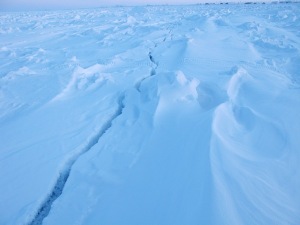We’re getting there! With our team mostly in place (Debbie Bronk and Karrie Sines arrived today), we’re now only missing our fearless leader Tish Yager. Tish, due to family obligations, couldn’t arrive until Thursday.
Today, after a brief meeting with our logistical support team, it was decided that we would set-up our ice camp in the early afternoon. The crack in the ice is still a concern because it indicates that the ice is still moving, but the experts think that the risk of the fast ice breaking-up is small.  We’re watching it carefully, but moving forward with our plans.
We’re watching it carefully, but moving forward with our plans.
The logistics team took care of most of the work setting up camp, but Zac and Tara went along to lend a hand and to advise the team on the specific location of the tents, the ice holes, and the placement of the heaters and generators. It is important that any potential contamination of our samples is minimized and so that our sampling can be conducted as efficiently as possible. The trip went smoothly, our camp was established, and I heard that the camaraderie was good.
Tony’s joke; told while drilling an ice hole.
How do you catch a polar bear?
Put some frozen peas around an ice hole, wait for a bear to come take a pea and kick him in the ice hole.
Say it out loud and you’ll get it. I know…., you had to be there, but Zac took videos.
Imagine the situation, out on the ice in the extreme cold and surrounded by the beauty of an Arctic winter day, its enough to drive anyone a little cold crazy.
Meanwhile, the rest of us remained on the station setting-up our labs and making sure that we would be ready for tomorrow’s planned first sampling. Not so exciting, but it really is satisfying to finally see the results of the months of planning realized. And we’re even more excited to generate the results from our winter experiments.
We are guessing that we’ll see major differences in microbial activities and communities in the winter compared to the spring and summer. We are especially eager to observe how the bacteria are using various forms of nitrogen. Nitrogen is a limiting nutrient for phytoplankton and phytoplankton form the base of the food web that ultimately feed all the larger organisms including whales and humans.
One of the central hypotheses of our project is that if the permafrost melts and releases large amounts of nitrogen-poor humic materials that are stored there, this will increase the use of dissolved inorganic nitrogen by bacteria. If this occurs, potentially there will be less nitrogen available for the phytoplankton in the spring when the lights come back on and consequently less food for all the larger organisms. Our experiments this week should tell us whether the logic of this idea is correct.
With the ice camp established and our labs set-up, we’re ready to start collecting samples tomorrow. Wish us luck!
marc




